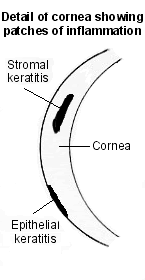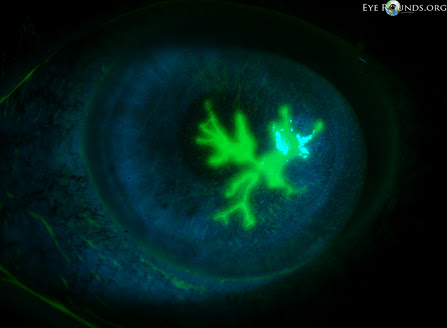Herpes simplex Type 1- A cold sore in the eye
Herpes simplex eye infection is caused by a type of virus known as Herpes Simplex Type 1.
The occurrence of the first episode of infection of this virus is referred to as the “primary infection”. This is often seen in childhood. It is normally passed on by close contact including kisses from family members with a cold sore. This virus lives in the Trigeminal nerve of the face and can either travel down to the mouth to cause cold sores or up through the branches to the eye.
Once infected, this virus can lay dormant in the root of the nerve of the face, till it gets triggered again.
Type 2 Herpes simplex is generally the cause of genital herpes, which rarely causes cold sores or eye infections.
The dreaded cold sore.
We all associate Type 1 Herpes simplex as the cold sores we see around the mouth area.
They often arise after episodes of stress, illness or sun exposure. Individuals can also be unfortunate and have this virus affect the eye. These people will have had previous cold sores during their lifetime.
The episode often clears but in many cases the infection can cause permanent scarring to the cornea. This can result in permanent visual loss, especially if this scarring is central.
Early treatment with an antiviral eye ointment (often Zovirax) can help prevent permanent corneal scarring.
Ocular herpes simplex type 1 is more prevelent in people who wear contact lenses.
What are the symptoms and signs of Herpes simplex Type 1 ocular active infection?
Blurred vision
Red eye
Sore eye
Photophobia
Watery discharge of the eye
Which part of the eye is affected by herpes simplex infection?
The cornea is the transparent front part of the eye. The virus attacks this clear tissue, with the infection causing inflammation often called keratitis. Keratitis of the deeper stromal layers is more serious than the infection of the superfical epithelial layer.
This can cause pain, discomfort, visual disturbance and a watery eye.
Repeated episodes of Herpes Simplex virus can eventuate into significant visual scarring and loss, as well as a desensitised cornea.
Should you, your child or your family members have similar symptoms, an immediate visit to your optometrist is recommended.
The optometrist will differentiate this infection by using a slit lamp and putting some colored stains, yellow, red and occasionally green into your eye.
A Herpes infection will be obvious due to the dendritic (branch like) ulcer on the slit lamp.
Prevention
Recurrusnce on active herpes can be reduced by wearing sunglasses in sunlight, and staying healthy. There is limited evidence but women often find these viruses activated during menstruation and others find they are triggered during times of ill health or stress.
Such cases may benefit from Oral Alovoir.
Prognosis
Most infections heal nicely
Epithelial keratitis settles the quickest with minimum vision loss and scarring.
Stromal keratitis tends to result in scarring, corneal clouding and some vision loss if central cornea
Recurring episodes can make existing scars increase in size.
Desensitised corneas are common in eyes with recurrent infections.
Impaired vision can result in inabitliy to drive especially at night due to the light being diffracted off a acared cornea resulting in halos and rainbows.
Overall, good vision remains in about 9 in 10 eyes affected by Herpes Simplex virus infection – that is, vision good enough to drive. However, severe and recurrent herpes simplex eye infections may lead to serious scarring, impaired vision and even severe sight impairment in some cases. If severe sight impairment does develop, a corneal transplant may be the only option to restore vision.
courtesy of http://www.patient.co.uk
photos from webbed.opth.uiowa.edu


